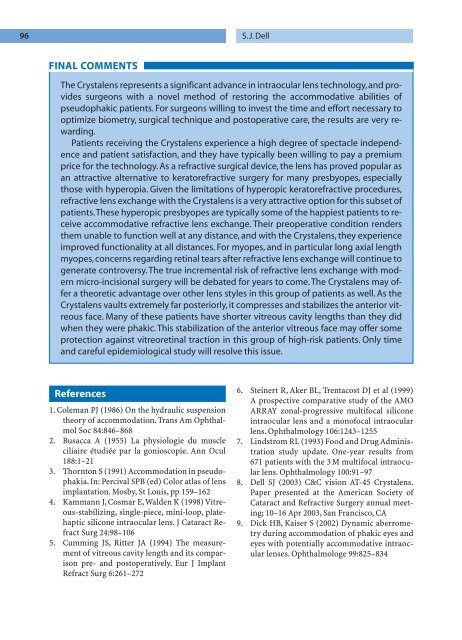Refractive Lens Surgery
Refractive Lens Surgery
Refractive Lens Surgery
You also want an ePaper? Increase the reach of your titles
YUMPU automatically turns print PDFs into web optimized ePapers that Google loves.
96 S.J. Dell<br />
FINAL COMMENTS<br />
The Crystalens represents a significant advance in intraocular lens technology,and provides<br />
surgeons with a novel method of restoring the accommodative abilities of<br />
pseudophakic patients. For surgeons willing to invest the time and effort necessary to<br />
optimize biometry, surgical technique and postoperative care, the results are very rewarding.<br />
Patients receiving the Crystalens experience a high degree of spectacle independence<br />
and patient satisfaction, and they have typically been willing to pay a premium<br />
price for the technology. As a refractive surgical device, the lens has proved popular as<br />
an attractive alternative to keratorefractive surgery for many presbyopes, especially<br />
those with hyperopia. Given the limitations of hyperopic keratorefractive procedures,<br />
refractive lens exchange with the Crystalens is a very attractive option for this subset of<br />
patients.These hyperopic presbyopes are typically some of the happiest patients to receive<br />
accommodative refractive lens exchange. Their preoperative condition renders<br />
them unable to function well at any distance, and with the Crystalens, they experience<br />
improved functionality at all distances. For myopes, and in particular long axial length<br />
myopes, concerns regarding retinal tears after refractive lens exchange will continue to<br />
generate controversy. The true incremental risk of refractive lens exchange with modern<br />
micro-incisional surgery will be debated for years to come. The Crystalens may offer<br />
a theoretic advantage over other lens styles in this group of patients as well. As the<br />
Crystalens vaults extremely far posteriorly, it compresses and stabilizes the anterior vitreous<br />
face. Many of these patients have shorter vitreous cavity lengths than they did<br />
when they were phakic. This stabilization of the anterior vitreous face may offer some<br />
protection against vitreoretinal traction in this group of high-risk patients. Only time<br />
and careful epidemiological study will resolve this issue.<br />
References<br />
1. Coleman PJ (1986) On the hydraulic suspension<br />
theory of accommodation. Trans Am Ophthalmol<br />
Soc 84:846–868<br />
2. Busacca A (1955) La physiologie du muscle<br />
ciliaire étudiée par la gonioscopie. Ann Ocul<br />
188:1–21<br />
3. Thornton S (1991) Accommodation in pseudophakia.<br />
In: Percival SPB (ed) Color atlas of lens<br />
implantation. Mosby, St Louis, pp 159–162<br />
4. Kammann J, Cosmar E,Walden K (1998) Vitreous-stabilizing,<br />
single-piece, mini-loop, platehaptic<br />
silicone intraocular lens. J Cataract Refract<br />
Surg 24:98–106<br />
5. Cumming JS, Ritter JA (1994) The measurement<br />
of vitreous cavity length and its comparison<br />
pre- and postoperatively. Eur J Implant<br />
Refract Surg 6:261–272<br />
6. Steinert R, Aker BL, Trentacost DJ et al (1999)<br />
A prospective comparative study of the AMO<br />
ARRAY zonal-progressive multifocal silicone<br />
intraocular lens and a monofocal intraocular<br />
lens. Ophthalmology 106:1243–1255<br />
7. Lindstrom RL (1993) Food and Drug Administration<br />
study update. One-year results from<br />
671 patients with the 3 M multifocal intraocular<br />
lens. Ophthalmology 100:91–97<br />
8. Dell SJ (2003) C&C vision AT-45 Crystalens.<br />
Paper presented at the American Society of<br />
Cataract and <strong>Refractive</strong> <strong>Surgery</strong> annual meeting;<br />
10–16 Apr 2003, San Francisco, CA<br />
9. Dick HB, Kaiser S (2002) Dynamic aberrometry<br />
during accommodation of phakic eyes and<br />
eyes with potentially accommodative intraocular<br />
lenses. Ophthalmologe 99:825–834



